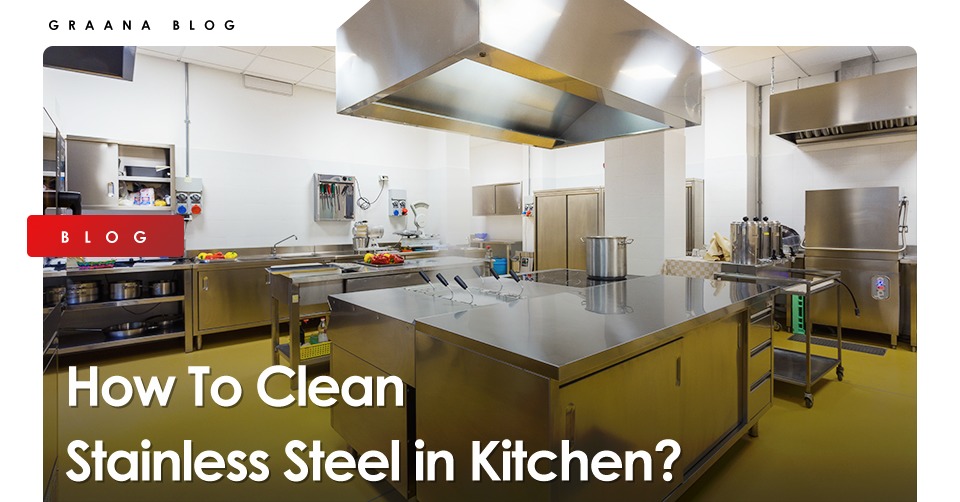When your brand-new appliances such as a fridge, an oven, or any other arrive at your home for the first time, it has that shine that brightens up your kitchen instantly. Over time, your appliance loses its sparkle and pristine thanks to the smudges and fingerprints, water droplets, etc. fortunately, there are several ways to revive your stainless steel appliances, no matter how old they may be.
Stainless steel appliances are durable and look beautiful in your kitchen no matter where you place them. However, streaks, water drips, fingerprints, and grease splatters happen almost every day, even to the most sustainable appliance or cookware.
Be it a saucepan or the kitchen sink; every individual owns at least one or two stainless steel products in his house. Stainless steel is popular and in high demand because of the combination of practicality and smooth brushed finish making it perfect for daily routine. Regardless of its name, the metal can lose its shiny outlook and get stained and dirty or not cleaned properly. Keep reading to know some helpful hacks on how to keep your stainless steel items squeaky clean and good as new.
Choosing a homemade cleaning product is a risky move since these products can be abrasive. Hence, we recommend cleaning your appliances or stainless steel items using a store-bought cleaner by testing small spots first before applying them entirely to the product.
Types of Stainless Steel Appliances
Stainless steel comprises pots, pans, large and small appliances, ovens, cookware, etc. Some ideal stainless steel kitchen appliances that are in every household are:
- Microwaves
- Stovetops/ stoves
- Dishwashers
- Range hoods
- Blenders
- Refrigerators
- Mixing bowls
- Sinks
Stainless steel products are popular in the market and are used in many kitchens; in addition to titanium and black stainless steel, color is available. But, stainless steel can smudge and streak if not cleaned regularly.
How to Clean Stainless Steel
Luckily, stainless steel is very easy to clean. Just one wipe and all the streaks and smudges are long gone. However, you might need a little elbow grease to remove oil residue or fingerprints. If you don’t have any stainless steel cleaner, you may incorporate homemade cleaners for a quick clean-up. Try to avoid powders, steel wool, or bleach to protect the appliance’s finish from damage.
- Dish Soap: Mix 1-quart hot tap water with one teaspoon of dish detergent. Use a microfiber cloth, and dip it in the mixture or detergent solution onto the area that needs cleaning in small sections. Rinse it off with clean water and dry with a clean cloth immediately.
- Mineral Oil: Remember: less is more. Apply a small amount of mineral oil and buff well to avoid stickiness. Make sure you don’t use any food oil such as olive oil, canola or vegetable oil, etc. because they can turn rancid. More minerals result in more spots. Rinse the excess and dry the surface with a paper towel or a reusable cloth to avoid etching, staining, and water spots. Water spots are usually formed when minerals in the water are left behind after evaporation.
- Windex: Clean the surface by spraying a dry cloth with ammonia and vinegar–free window cleaner. Wipe the surface thoroughly, and you are done.
- Go with the Grain: It is a fact that stainless steel has grain. Yup, that’s right. You may notice lines on stainless steel and feel the grain by touching the surface with your fingers. Start cleaning the top of your appliance and wash in the same direction as the grains. If the grains are horizontal, work your way horizontally by starting from the top and then towards the floor. If you clean against the grain, it will lead to scratching, damaging your appliance.
To scrub your stainless steel pots and sinks is okay as long as you do it in circular motions. It helps in hiding the scratches and gives them a shine. It is very important to clean the appliances in the direction of the grains to minimize streaks.
How to Get Streaks off Stainless Steel Appliances
No matter what kind of stainless steel item you own, it is important that you clean your appliances in the direction of the metal’s grain. For extra shine and pristine, use an excellent cleaner to dissolve grease and buff with a clean microfiber cloth.
How to Get Stainless Steel to Shine Again
However, the best way to bring your appliances back to life and their natural shine is by using store-bought cleaners and solutions. Using dish soap and miner oil is a hood hack for cleaning stainless steel appliances. The reason why they work better than homemade cleaners is that they are specifically made for stainless steel. Moreover, invest in a cleaner with a protectant to resist soil and fingerprints. This way, you won’t have to clean your appliances now and then.
Why Stainless Steel Appliances Get Greasy
Ever wonder why there are tiny spots around your stainless steel pots? Whenever you are cooking in your kitchen, there is always a splatter of either food or oil onto the stove. This happens when fats and oils are heated and splatter around your pot, creating tiny grease particles- gradually setting on countertops, stainless steel appliances, and backsplashes.
Benefits of Stainless Steel Appliances and Cookware
Stainless steel offers modern aesthetics. The shine lifts the entire look of the kitchen. Moreover, stainless steel is very durable, which is very beneficial for kitchen-related tasks.
- Cleaning: The surface of stainless steel is smooth. It leaves no room for any particle or bacteria to root in. The texture of stainless steel appliances is also effortless to clean. One can use a range of cleaners such as Dawn Platinum with water to lean off grease stains and spots and then rinse off and wipe it with a dry towel.
- Durability: Stainless steel appliances are rust-resistant as compared to other materials. Hence, it outlasts other materials—the reason why stainless steel appliances are not replaced that often.
- Non-reactivity: Foods containing high acid content can damage your stainless steel cookware. Foods with a high acid content can cause damage to some cookware metals. However, stainless steel is resistant to this problem. There is no flavor tainting or staining whether you’re making tomato sauce or a roast. With so many benefits, no wonder stainless steel is a must-have for every kitchen.
What to Avoid When Cleaning Stainless Steel Appliances
Stainless steel has long durability, but it’s not immune to damage. Many appliances come with a pristine finish, vulnerable to scratches and dullness over time. Here are some don’ts when cleaning your stainless steel appliances:
Abrasive cleaners: Never use steel wool on your stainless steel appliances because they can easily scratch the shine and finish of your appliances. Instead, use a microfiber cloth or a soft material cloth when cleaning stainless steel appliances. Also, use dish soap like Dawn Platinum. It has a unique formula that is strong enough to erase stubborn grease marks and stains while staying gentle on stainless steel surfaces.
Air-drying: Wipe away the dirty or soiled water and any other residue with a reusable cloth. Allowing water and cleaning solution to air-dry will cause streaks and permanent spots that will damage the finish and quality of stainless steel.
Tap water: It is essential to be mindful of the type of water that runs in your kitchen. Some tap waters are harsh, leaving spots and stains in the sink. To clean stainless steel, it is suitable to use distilled or filtered water.
If you are unsure how to clean your stainless steel appliances, give a quick read to the manufacturer’s manual or instruction book. It is surprisingly beneficial!
Read More:
13 Bad Housekeeping Habits You Need to Quit




